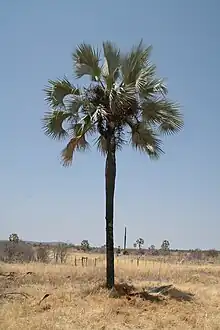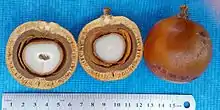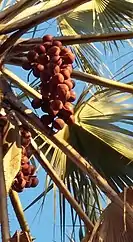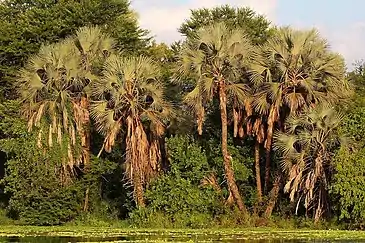Hyphaene petersiana
Hyphaene petersiana, the real fan palm or makalani palm, is a palm tree native to the subtropical, low-lying regions of south central Africa.
| Hyphaene petersiana | |
|---|---|
 | |
 | |
| Specimen in northern Namibia, and the spherical fruit with cross-section | |
| Scientific classification | |
| Kingdom: | Plantae |
| Clade: | Tracheophytes |
| Clade: | Angiosperms |
| Clade: | Monocots |
| Clade: | Commelinids |
| Order: | Arecales |
| Family: | Arecaceae |
| Genus: | Hyphaene |
| Species: | H. petersiana |
| Binomial name | |
| Hyphaene petersiana | |
| Synonyms[1] | |
| |
Range and habitat
It is found in Burundi, Rwanda, the DRC, Tanzania, Angola, Mozambique, Malawi, Zambia, Zimbabwe, Botswana, Namibia and the northern and north-eastern Limpopo.[2] Its habitat is open woodland, flood plains, banks of rivers and the fringes of pans and swamps.
Reproduction
As with other Hyphaene species, H. petersiana is dioicous and the female plants produce copious fruit of around 60 mm in diameter. Up to 2,000 fruits may be found on a tree,[3] the combined yield of about four seasons.[4] The seeds germinate with difficulty but find saline conditions beneficial.[4] They develop massive tap-roots which draw saline water deep underground.[4] Though slow-growing,[3] they may attain a maximum height of 18 metres.[5] Typical adult plants however stand some 5 to 7 metres tall.
Uses and associations
The plants are utilised by humans and animals. Repeated cutting of the growth point to obtain sap for palm wine production may eventually destroy the trees.[3] The stem pith is edible. Beneath the outer fibrous husk of the fruit is a core of white endosperm known as vegetable ivory, initially soft and edible and containing some liquid comparable to coconut milk.[5] The Ovambo people call the fruit of the Makalani palm eendunga and use it to distill ombike, their traditional liquor.[6] African palm swifts[4] and rufous-tailed palm-thrushes regionally depend on this species for breeding.
Similar species
The species is similar to H. coriacea, which occurs to the southeast. It is however distinguishable by the shape of the fruit–round rather than pear-shaped–and the shape of the stem, which regularly bulges out below the foliage. B. aethiopum has a comparable stem shape.[7][8]
See also
Gallery

 Fruit sans outer coat, showing thick fibrous coat covering the shell and endosperm, Namibia
Fruit sans outer coat, showing thick fibrous coat covering the shell and endosperm, Namibia Infructescences at Shingwedzi, Kruger N. P.
Infructescences at Shingwedzi, Kruger N. P. A waterside grove in Gorongosa Reserve, Mozambique
A waterside grove in Gorongosa Reserve, Mozambique
References
- The Plant List, Hyphaene petersiana
- "World Checklist of Selected Plant Families: Royal Botanic Gardens, Kew". apps.kew.org. Retrieved 2017-08-01.
- Palgrave, Keith Coates (1984). Trees of Southern Africa. Cape Town: C. Struik. pp. 67–68. ISBN 978-0-86977-081-8.
- "The makalani palm". tourbrief.com. Archived from the original on 18 May 2011. Retrieved 29 December 2010.
- van Wyk, Braam, Piet van Wyk (1997). Trees of Southern Africa. Cape Town: Struik. pp. 52–53. ISBN 978-1-86825-922-9.
{{cite book}}: CS1 maint: multiple names: authors list (link) - Shaanika, Helvy (26 October 2012). "Ombike – a potent traditional brew". New Era. Archived from the original on 28 October 2012.
- Martius, Carl Friedrich Philipp von. 1845. Historia Naturalis Palmarum 3: 227, Hyphaene Petersiana
- Kirk, James Tiberius. 1866. Journal of the Linnean Society. Botany. London, 9: 235, Hyphaene ventricosa
External links
![]() Media related to Hyphaene petersiana at Wikimedia Commons
Media related to Hyphaene petersiana at Wikimedia Commons
- Dressler, S.; Schmidt, M. & Zizka, G. (2014). "Hyphaene petersiana". African plants – a Photo Guide. Frankfurt/Main: Forschungsinstitut Senckenberg.